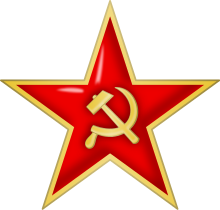"The Red Army Is the Strongest",[a] popularly known by its incipit "White Army, Black Baron",[b] is a Soviet march song written by Pavel Gorinshtein and composed by Samuel Pokrass. Written in 1920, during the Russian Civil War, the song was meant as a combat anthem for the Red Army.
| English: The Red Army Is the Strongest | |
|---|---|
| Красная Армия всех сильней | |
 Red Army headgear insignia | |
Combat anthem of the Soviet Union | |
| Lyrics | Pavel Gorinshtein |
| Music | Samuel Pokrass |
| Adopted | 1920 |
| Relinquished | 1991 |
History
The immediate context of the song is the final Crimean offensive in the Russian Civil War by Pyotr Wrangel's troops in July 1920. The second verse refers to the call to a final effort in the Crimea published by the Revolutionary Military Council in Pravda on 10 July.
While the song has a separate refrain, the verses repeat the claim that "The Red Army is stronger than all", which came to be the song's conventional title.[citation needed] The first verse of the song reads as follows:
Белая армия, чёрный барон |
The White Army and the Black Baron |
"Black Baron" was a nickname of Wrangel's, from his alleged penchant for wearing (and dressing some of his elite units in) black uniforms. Wrangel's offensive was indeed halted by the Red Army, and Wrangel and his troops were forced to retreat to Crimea in November 1920, pursued by both Red and Black Army cavalry and infantry. Wrangel and the remains of his army were evacuated from Crimea to Constantinople on 14 November 1920.
The song's melody is possibly inspired by Eastern European Jewish folk-music, as one passage is also heard in the Yiddish song "Dus Zekele mit Koilen" ('The Little Coal Sack'), whose opening bars possibly also inspire those of the Italian protest song "Bella Ciao".[1][2]
The song became popular in the early days of the Soviet Union. It was sung in 1923 at the rally in Leningrad against the Curzon Line, the "British seas" acquiring new significance in view of Lord Curzon's ultimatum. In a letter to a school for blind students in the Vologda region, Nadezhda Krupskaya—wife of Vladimir Lenin—named it as one of her favorite songs alongside "The Internationale". The phrase "from the taiga to the British Seas" became something of an idiomatic expression used by other authors, such as by V. A. Lugovsky in his 1926 poem "Pesni o vetre" ('Song About the Wind').[citation needed]
In its early oral transmission from 1920 to 1925, the song underwent some variations. Gorinshtein later recalled that his original lyrics had four or five verses, and that his original refrain was slightly different.[citation needed]
The march was first printed in 1925, and subsequently published under the titles of «От тайги до британских морей» ('For from the Taiga to the British Seas'), «Красная армия» and «Красноармейская» ('Red Army'). It was not until 1937 that the conventional title had settled on «Красная Армия всех сильней» ('The Red Army Is the Strongest to Be!'). Between the 1920s and the 1940s, the song was reproduced without indication of its authors. It was only in the 1950s that musicologist A. Shilov established the authorship of Gorinshtein and Pokrass.[citation needed]
The march was adopted by the Chapaev Battalion of the International Brigades in the Spanish Civil War, and it was allegedly sung in a Nazi torture chamber by Czech communist Julius Fučík. Alternative Russian lyrics were set to the tune during World War II, e.g. «Всем нам свобода и честь дорога» by Pyotr Belyi in 1941.[3]
In Red Vienna, the tune was used for the song „Die Arbeiter von Wien“ ('The Workers of Vienna'), highlighting those fighting for a bright future of the proletariat.
Lyrics
Russian original
| Cyrillic script | Latin script | IPA transcription[c] |
|---|---|---|
I |
I |
1 |
Translations
| English version | Chinese version by Xue Fan |
Esperanto version |
|---|---|---|
I |
一 |
I |
Other variations
The tune was also used for communist songs in other languages, including in German in the Weimar Republic by German communists in the 1920s. An early German version with the incipit „Weißes Gesindel und adlige Brut“ ('White Riffraff and Noble Scum') was a free translation of the original lyrics:[4]
Weißes Gesindel und adlige Brut |
White riff-raff and noble scum |
„Die Arbeiter von Wien“ was written by Fritz Brügel in 1927, following the July Revolt. It became popular through its use by Austrian socialists and by members of the Republikanischer Schutzbund, who fought the Dollfuss regime in the short-lived Austrian Civil War in February 1934.[5] The first verse of Brügel's version reads:
Wir sind das Bauvolk der kommenden Welt, |
We are the builders of the coming world, |
The German version was further adapted into Turkish, as "Avusturya İşçi Marşı" ('Austrian Workers' March'). The first verse of Turkish version reads:
Hayat denilen kavgaya girdik, çelik adımlarla yürüyoruz |
We walked into a fight called "life", we step with feet of steel |
See also
Notes
- Russian: Красная Армия всех сильней, romanized: Krásnaja Ármija vseh siljnéj, IPA: [ˈkrasnəjə ˈarmʲɪjə fsʲex sʲɪlʲˈnʲej]
- Russian: Белая Армия, Чëрный Барон, romanized: Bélaja Ármija, Čjórnyj Barón, IPA: [ˈbʲeləjə ˈarmʲɪjə ˈtɕɵrnɨj bɐˈron]
- See Russian phonology and Help:IPA/Russian.
References
Further reading
External links
Wikiwand in your browser!
Seamless Wikipedia browsing. On steroids.
Every time you click a link to Wikipedia, Wiktionary or Wikiquote in your browser's search results, it will show the modern Wikiwand interface.
Wikiwand extension is a five stars, simple, with minimum permission required to keep your browsing private, safe and transparent.
